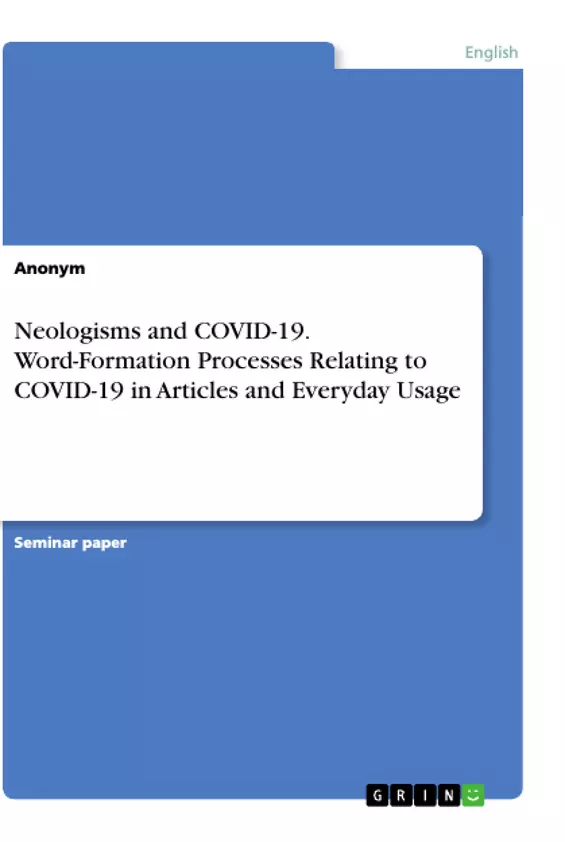This term paper will guide the reader through a linguistic analysis of different word-formation processes in new words related to COVID-19.
The Coronavirus disease, also known as COVID-19, is an infectious disease affecting the respiratory system. More and more confirmed cases are being reported worldwide with each passing day. It first started in China towards the end of 2019. However, the virus became unstoppable and resulted in an ongoing pandemic. Not only has the virus led to numerous far-reaching educational, political, psychological, and social impacts, but also a major outbreak of new words and idioms. "Established terms such as self-isolating, pandemic, quarantine, lockdown and key workers have increased in use, while coronavirus/ COVID-19 neologisms are being coined quicker than ever" (Lawson 2020). These new words are quickly becoming part of our daily terminology as the virus continues to spread and kills more and more people all over the world. The meaning of many words is probably known, but where these terms also familiar to us six months ago?
Nevertheless, what do we understand under the concept of neologisms? Which words have entered the dictionaries? The corpus of this work consists of four articles/ websites from which the analyzed words are taken. The theoretical part consists of definitions and explanations of different word-formation processes, such as abbreviations (including acronyms and initialisms), compounding, blending, and conversion. The third section contains a detailed analysis of 15 words for which concepts from the theoretical part will be used. Subsequently, the conclusion will sum up the findings.
Inhaltsverzeichnis (Table of Contents)
- 1. Introduction
- 2. Theoretical Background
- 2.1. Neologisms
- 2.2. Abbreviations
- 2.2.1. Acronyms
- 2.2.2. Initialisms
- 2.3. Compounding
- 2.4. Blending
- 2.5. Conversion
- 3. Analytical Part
- 3.1. Neologisms Formed by Abbreviation
- 3.2. Neologisms Formed by Compounding
- 3.3. Neologisms Formed by Blending
- 4. Conclusion
Zielsetzung und Themenschwerpunkte (Objectives and Key Themes)
This term paper aims to analyze the word-formation processes involved in the creation of neologisms related to COVID-19. It explores how the pandemic has rapidly expanded the English vocabulary and examines specific linguistic mechanisms at play. The analysis focuses on a corpus of articles and websites, utilizing linguistic theory to understand the observed phenomena.
- Neologism formation during the COVID-19 pandemic
- Analysis of word-formation processes (abbreviation, compounding, blending, conversion)
- The impact of COVID-19 on the English lexicon
- Linguistic mechanisms of vocabulary expansion
- Examples of neologisms and their formation
Zusammenfassung der Kapitel (Chapter Summaries)
1. Introduction: This introductory chapter establishes the context of the paper by highlighting the significant increase in neologisms related to COVID-19. It emphasizes the timeliness and relevance of the topic, given the rapid evolution of language during the pandemic. The chapter introduces the concept of neologisms and their importance in understanding contemporary language use, particularly in media related to the pandemic. It outlines the scope of the paper, focusing on a linguistic analysis of word-formation processes using a corpus of articles and websites. The introduction effectively sets the stage for the theoretical and analytical sections that follow.
2. Theoretical Background: This chapter lays the theoretical foundation for the analysis by defining and explaining key word-formation processes relevant to the study of COVID-19-related neologisms. It specifically focuses on abbreviations (including acronyms and initialisms), compounding, blending, and conversion. Each process is carefully defined and illustrated with examples, providing a comprehensive overview of the linguistic tools used in the subsequent analytical section. The chapter serves as a crucial bridge, linking linguistic theory to the practical application of analyzing neologisms in a real-world context.
Schlüsselwörter (Keywords)
Neologisms, COVID-19, word-formation processes, abbreviations, acronyms, initialisms, compounding, blending, conversion, linguistic analysis, vocabulary expansion, pandemic lexicon, English language.
Frequently Asked Questions: Comprehensive Language Preview on COVID-19 Neologisms
What is the focus of this language preview?
This preview offers a comprehensive overview of a term paper analyzing word-formation processes (neologisms) related to the COVID-19 pandemic. It examines how the pandemic influenced the English language, focusing on the creation of new words through abbreviation, compounding, blending, and conversion.
What topics are covered in the Table of Contents?
The preview includes a detailed table of contents covering an introduction, a theoretical background section explaining neologism formation processes (neologisms, abbreviations, acronyms, initialisms, compounding, blending, conversion), an analytical part applying these processes to COVID-19 related neologisms, and a conclusion.
What are the key objectives and themes of the term paper?
The main objectives are to analyze neologism formation during the COVID-19 pandemic, explore specific word-formation processes, and assess the impact of the pandemic on the English lexicon. Key themes include the linguistic mechanisms of vocabulary expansion and examples of neologisms and their formation.
What does the Theoretical Background section cover?
This section defines and explains key word-formation processes: abbreviations (acronyms and initialisms), compounding, blending, and conversion. Each process is illustrated with examples, providing a theoretical foundation for the subsequent analysis of COVID-19 related neologisms.
What kind of analysis is performed in the Analytical Part?
The analytical part applies the theoretical framework to a corpus of articles and websites, focusing on neologisms formed through abbreviation, compounding, and blending. It provides concrete examples from the corpus to illustrate the identified processes.
What is included in the Chapter Summaries?
The preview provides summaries for the introduction, which sets the context and scope of the study, and the theoretical background chapter, which details the linguistic concepts applied in the analysis. It highlights the structure and purpose of each chapter.
What are the key words associated with this term paper?
Keywords include: Neologisms, COVID-19, word-formation processes, abbreviations, acronyms, initialisms, compounding, blending, conversion, linguistic analysis, vocabulary expansion, pandemic lexicon, and English language.
What is the intended audience for this preview?
This preview is intended for academic use, supporting the analysis of themes in a structured and professional manner.
- Quote paper
- Anonym (Author), 2020, Neologisms and COVID-19. Word-Formation Processes Relating to COVID-19 in Articles and Everyday Usage, Munich, GRIN Verlag, https://www.grin.com/document/955872



